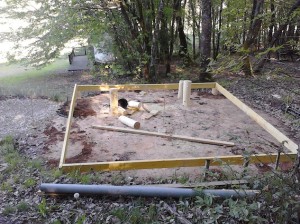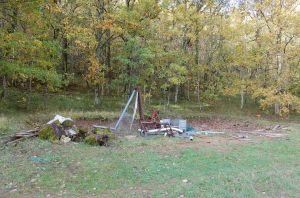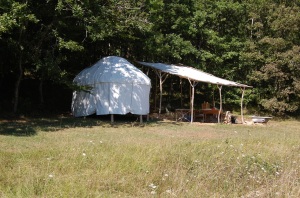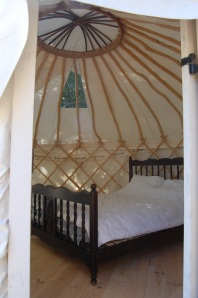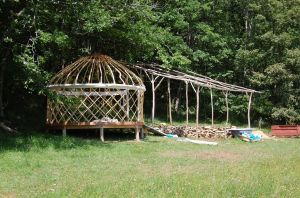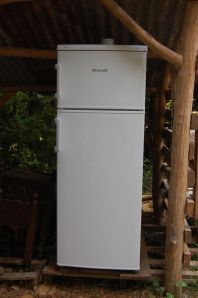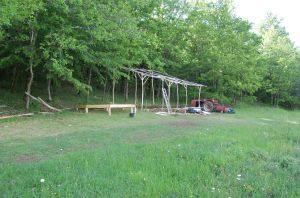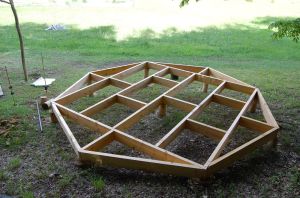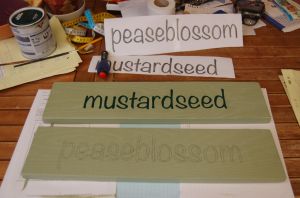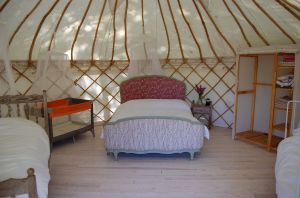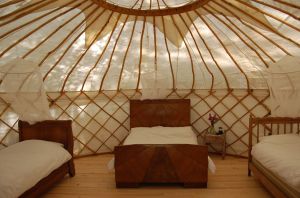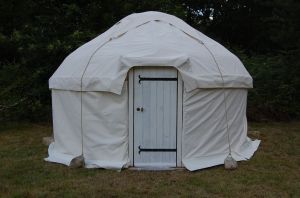Here’s the state of the Mustardseed floor at the moment. I’m going with the same frame layout as the 12-foot last year and there’ll be a ramp to the door like the Play Yurt you can see just down the slope. It’ll be lovely.
April 17, 2014
April 14, 2014
Dawn this morning – almost actual speed
Posted by Alexander under Uncategorized | Tags: one-minute video, yurts |Leave a Comment
A couple of years ago, after the camping season ended, we stayed in “Peaseblossom” in écovallée. I was lying in bed with the door open as the sun came up over the trees opposite. It felt like it was rising just for me – a magical experience, which I’ll treasure for the rest of my life.
This morning, I sat there with my cheap phone and took a video to give you some idea what it was like. The microphone’s not great on the phone, so I added the first song that came into my head. “Here comes the sun” might have been a better choice. But you can always turn the sound off here and put that on instead.
March 19, 2014
Necessity is also the mother of having to do things twice
Posted by Alexander under Uncategorized | Tags: construction, yurts |[5] Comments
Last year, we noticed the floor of “Mustardseed”, one of the two family yurts in écovallée, pulling apart. It didn’t seem to be going back together on its own, so we waited for a dry spell and decided to have a really good look.
This is what we found:
The two short joists by the door had been pivoting on their screws and lifting the floor, which explains why the door was catching on the boards at that point. It did seem strange.
Several of the screws had sheared off, and parts of the frame had moved several inches. Which explains why the floor was so gappy. I imagine this is because I was using green (freshly cut) wood (douglas fir), which tightened up and snapped the screws. (A carpenter might have a view on this.) This choice of wood was driven by necessity and habit – necessity because we didn’t have much money at the time and the wood was cheap, and habit because this is how I’d done it before. (I won’t be doing it like this again.)
The ground was very cracked – and this may have led to some of the movement and shearing.
Some of the frame wasn’t even attached any more. I used that crowbar to lift the floorboards, which all came up easily. I numbered them and stacked them nearby for re-laying.
Which shows just how portable a yurt camp can be (which could come in useful if we ever decide to relocate).
The weather’s holding, so I’ll be taking the joist frame apart and making a new one. Using shop-bought joists. Based on my 12-foot yurt joist frame. There’ll be a ramp this time and it will be even more beautiful than before. Which is one of the other benefits of doing something more than once – it gets better every time.
September 5, 2013
As promised: The new 12-foot yurt
Posted by Alexander under Uncategorized | Tags: construction, outdoor kitchen, yurts |[3] Comments
Back in November, in this post, I promised “an achingly beautiful 12-foot yurt with wooden floor, double bed and optional Moses basket, plus a baby-safe canvas-covered outdoor kitchen, featuring an off-grid fridge and grey water treatment”.
Here was the patch of land I started with:
And here it is today:
A little bit of (our) history
This yurt was originally going to be our family bathroom, way back at the start of the Big Green Idea. It’s the only yurt frame I actually helped to make, on a yurt building course with Matt and Mark in Stanmer Park (mentioned in more detail here). The frame is made from coppiced ash, much of which grew while we were living in Kemp Town a few miles away. It’s “achingly beautiful” as you can see…
…which fulfils part of that promise to you.
The canvas cover for the kitchen has also been with us from the beginning of this project. It was our groundsheet when we moved to France to live in a yurt just over six years ago. Although it didn’t appear in écovallée until June 2008 (I’ve never shown this shot before):
Since then, it has covered Pepito’s hay for several Winters, and has been dragged from one end of the field to the other (and back), for various reasons, numerous times. Her Outdoors squared it up and added an edge, using the last of our canvas, so we could put up the kitchen for only the cost of the string that goes round it.
As with other structures around here, the uprights for the kitchen and yurt platform are acacia from écovallée, sourced within a draggable distance.
The uprights for the kitchen side are oak from a few metres away. The sink was given to us a few years ago. The table came from a former hotel in Mauzac, as did the yurt door (which was a shutter originally) and bed frame. We did buy a new kitchen side and gas hob, and plumbing bits and pieces, but we’ve made every effort to keep the impact of this structure to a minimum.
Promise-wise, here’s the room for “an optional Moses basket”:
I was originally going to have the door facing down towards Pepito’s field, but I thought new parents might want to keep several eyes on the baby while they’ve having dinner, relaxing on the hammock, enjoying a bit of peace and quiet – and quite a lot of space.
One more shot before I go (it’s gone beer o’clock and it’s been fearsomely hot again today). There’s always something to be especially pleased with, even on quite a big project like this one. Here’s the bit of shaped shelving that makes me happy (cut with a seriously old coping saw that’s as blunt as a spoon):
There are a few more photos on an album on our facebook page. And I’ll take some proper shots for the website gallery when I’ve got a moment or few. But the only way to appreciate this little beauty properly is to come and see it for yourself.
July 10, 2013
The new 12-foot yurt
Posted by Alexander under Uncategorized | Tags: construction, yurts |Leave a Comment
July 3, 2013
New this year: Guilt-free refrigeration
Posted by Alexander under Uncategorized | Tags: ecovallee, refrigeration, yurts |[3] Comments
We have gone to great lengths to make écovallée the most perfect environmentally and family friendly yurt camp not just in the Dordogne, or France, but Western Europe – perhaps The World!
Our 18-foot Kyrgyz-style guest yurts are handcrafted coppiced chestnut, because we feel the natural lines are far more beautiful than sawn timber (the walls are also higher than Mongolian yurts, which is an added bonus). The yurts sit on locally sourced wood floors, and have comfy beds with good pillows and duvets, because we wouldn’t want anything less for ourselves. This is also why the safari-style outdoor kitchen has all the pots, pans, utensils and appliances you could want, including a large gas barbecue. And why there’s a stunning solar shower and beautiful tree bog compost toilet just a few metres down the field. Because we have young children, we included a special toy and game-filled Play Yurt just for kids. And we provide a Welcome Picnic for guests staying one week or more so parents can start relaxing as soon as they arrive.
Add Pepito the retired working horse, fresh eggs from the free-range chickens, rabbits, geese, acres of space, a trampoline, woodland play area, wildlife, peace and quiet, countless tourist attractions nearby, and a thriving 13th-Century market town a few hundred metres away, and you’d think we had thought of everything.
But you’d be wrong.
Last year, the cool boxes in the outdoor kitchen couldn’t cope with the heat of Summer, and it was clear we’d need to provide more reliable refrigeration. That refrigeration has now arrived and looks like this:
It’s rated A++ and has enough space for all three yurts, but obviously from an environmental point of view it still uses electricity we weren’t consuming before. To make this OK, with ourselves, our guests and the planet at large, we’ve signed up to France’s 100% renewable electricity provider – enercoop. Something we’ve been meaning to do for a while.
Now, we’re pretty sure we’ve thought of everything…
May 21, 2013
Moving slowly on…
Posted by Alexander under Uncategorized | Tags: construction, global warming, outdoor kitchen, Roaming Yurt, spring, weather, yurts |[2] Comments
We haven’t been enjoying our usual Spring weather recently, so work on… the… new 12-foot yurt area has… been somewh…at int… er… rupt… ed.
Her Outdoors has nearly finished the wall on which the kitchen will be built, though, and only needs a few hours for the roof (look at how lush that grass shouldn’t be):
And I need some dry (non-strimming) hours to paint Death to All Wood-Boring Insects on the joists and a couple of days to lay the floor.
I’m pleased with the new joist layout (not that anyone will see it after the floor goes down). It’s satisfyingly close to the original design.
February 11, 2013
New 12-foot yurt platform design
Posted by Alexander under Uncategorized | Tags: construction, yurts |[7] Comments
I think I’ve just come up with an elegant new joist plan for the next 12-foot yurt platform. It looks like this:
This plan uses larger joists than I normally do, in a square on four posts, with smaller joists between, strengthened by noggins.
Four extra posts will complete the “circle”, allowing my normal 23mm thick pine flooring to be secured close to the edge, which will carry the weight of the coppiced ash frame.
(The post in the middle isn’t necessary but I might include it to stop any bounce.)
Interestingly (to me, anyway), I tried three joist layouts on paper and all required 33 metres of joist. The other two needed 12 and 17 posts, though, which is why they didn’t win.
February 6, 2013
When we had one yurt in 2010, we called it “The Guest Yurt”. In 2011, when we added a second, this became “Guest Yurt 1”. But now we’re adding a third (and probably final) yurt, we had to come up with something different.
First, we considered naming them after the wild orchids that turn up in the Spring. Then after some of our favourite trees – but in English or French? (That was the question.)
Eventually, we settled on something that feels entirely appropriate for a dreamy, other-worldy, vaguely medieval holiday in the woods. Her Outdoors has been working on the signs.
Mustardseed is the yurt you can see in the banner at the top of the homepage, to the left of the kitchen when viewed from the other side of the valley. For those of you who haven’t read the website, it’s an 18-foot coppiced chestnut yurt, with one double bed, two singles, a pine floor and a solid oak, lockable door. (Formerly known as Guest Yurt 1.) Last year, I took this photo of the inside:
Peaseblossom is an almost identical 18-foot coppiced chestnut yurt on the other side of the kitchen. This also has the double and two singles, pine floor, lockable door etc (and was previously known as Guest Yurt 2). When we went on holiday here last year I discovered that, with the door open, the sun rises into your face as you’re lying in bed. (It was a magical moment.) Anyway, here’s the photo I took of it last year:
Puck is a 12-foot coppiced ash yurt that has only been used once so far, as a honeymoon yurt. This will have a double bed and cot bed or Moses basket if necessary, and its own kitchen and eating area. It will also be cheaper, which means more people can come here. Which is what it’s always been about. This is the only photo I have of Puck at the moment:
If you’ve just stumbled across this post while googlewhacking “Shakespearean yurt”, are now curious and want to know how little you need to stay here in 2013, here are the ecovallee prices.
The yurts are filling up faster than last year (which may have something to do with the weather in the UK). So if you want to book, don’t leave it too long.
October 5, 2012
Free studio – and other news
Posted by Alexander under Uncategorized | Tags: caravan, free buildings, home improvements, yurts |[9] Comments
So, the other half of my other half’s studio is almost finished:
In the right hand corner, there’ll be a seat/bed I’ll make when I get a moment. And opposite that will be a strange Dutch wood burner a friend gave us a few years ago.
As always happens, there are some really satisfying elements of this project. One is the curve of the hardboard patch under the window – it’s the off-cut from the window end, but it just works beautifully for some reason. Another is finding a visible place for that board with writing on it. The words are printed in Robbie Coltrane’s Eastern European accent from the Bond films: “Made in Republic of Belarus”. (They’re only little things, but they make me happy.)
But probably the best bit is the door:
More precisely, the aluminium (US: aluminum) upper hinge. It’s from the original caravan door but was completely seized. I nearly threw it away a few times, but just couldn’t do it. Then the moment came during the week when I thought I would have to buy some hinges. As you may know, we don’t have the budget for that. So I spent a few minutes with some oil, a couple of pairs of pliers, and some determination. It loosened up very s-l-o-w-l-y and eventually came apart in tact.
Which means, having spent a total of €0.00 (£0.00), the new studio is bang on budget.
Sadly, there’s no time to celebrate right now. Because we’re taking advantage of some excellent weather to prepare our yurts for the Winter. The wall of our living yurt has a massive hole that needs patching:
The hole happened for a couple of reasons. One, because there’s a very small gap behind the yurt that catches leaves in the Autumn:
And two, because the cover is made from cheap canvas that doesn’t cope at all well with rotting leaves.
As well as fixing this (in the new studio), we’re taking the roof off and re-proofing it, sealing the seams with silicon, bringing the insulation from the tractor shed, putting it all back together before dusk, cutting wood and a whole load of stuff I’ll remember as soon as I stop writing this.
Like digging away that embankment so we don’t have the same problem again next year.
